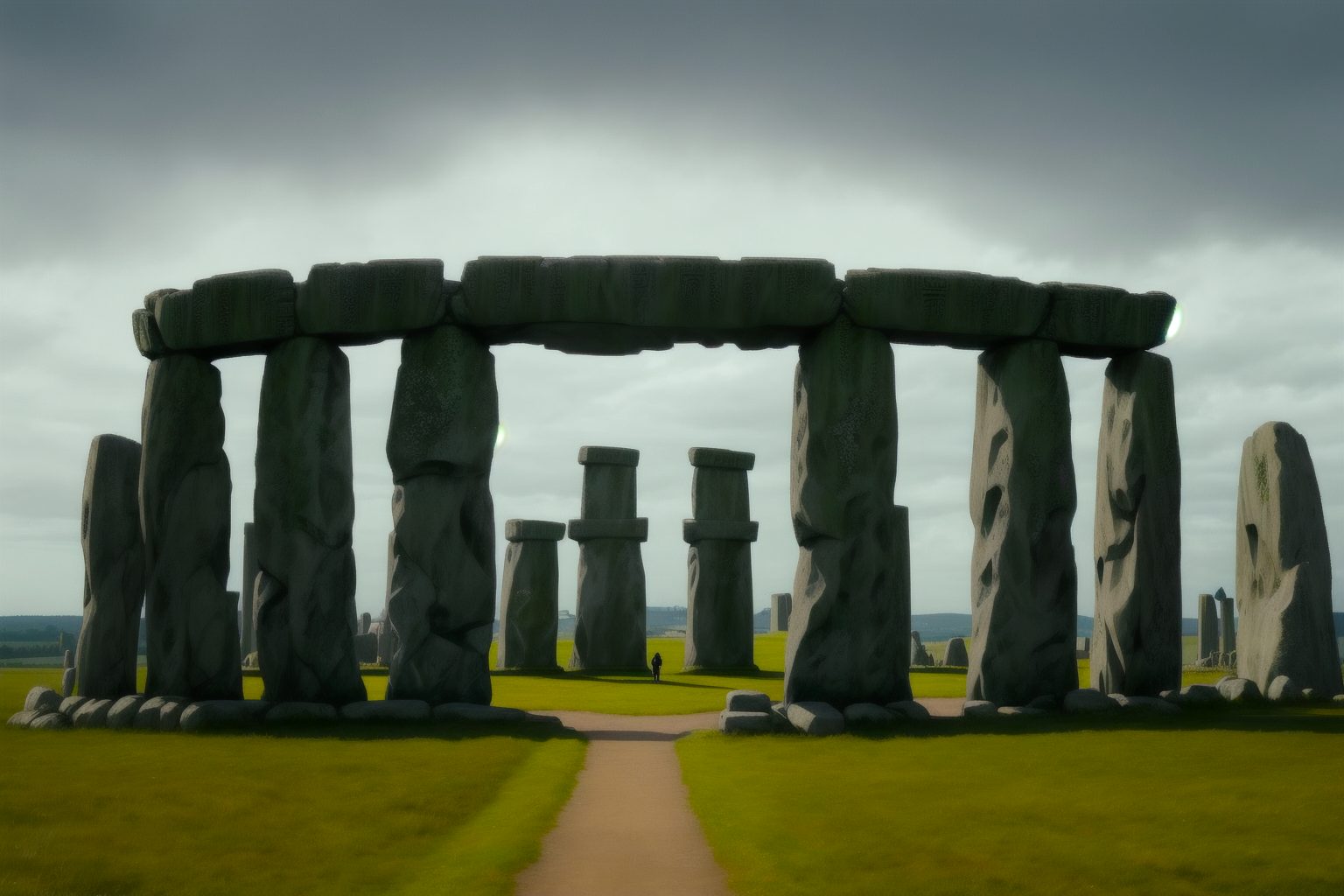Stonehenge: AI-Generated Image
Introduction:
Stonehenge, more than mere stones, symbolizes human innovation and resilience, nestled in the heart of Wiltshire, England. It has mystified historians, archaeologists, and visitors alike for centuries. Delve into its sacred symbolism – spiritual, astronomical, and societal intricacies ingeniously carved into its stones. A captivating fusion of history, culture, and mystery, Stonehenge invites us on a journey through time, shedding light on the remarkable people who constructed it and the world they inhabited.
1. History of Stonehenge
Stonehenge’s history is a captivating tale that stretches back thousands of years. It is a marvel that defies the erosion of time and unfolds its rich history through a fascinating construction timeline. Beginning around 3000 BCE, the monument’s evolution spans several phases, each marked by distinct architectural choices and technological advancements. From the simplicity of the first earthwork, known as the “Henge,” to the intricate arrangement of massive stones, Stonehenge’s construction reveals a captivating narrative of human ingenuity over centuries.
-
Timeline of Stonehenge’s construction:
– c. 3000 BCE: The first phase of Stonehenge begins, marked by the construction of a circular earthwork enclosure known as a henge.
– c. 2500 BCE: Bluestones from the Preseli Hills in Wales are transported to the site and erected in a double circle.
– c. 2400 BCE: The iconic sarsen stones, originating from the Marlborough Downs, are erected in a circular formation, with smaller bluestones placed within.
– c. 2200 BCE: Stonehenge reaches its final form, featuring the central horseshoe arrangement of sarsen stones, surrounded by a circle of bluestones.
-
Ancient cultures and their connection to Stonehenge:
Stonehenge’s allure lies not just in its stones but in the diverse cultures that contributed to its creation. The Neolithic and Early Bronze Age societies of prehistoric Britain played a significant role in Stonehenge’s construction, reflecting their advanced knowledge of engineering, astronomy, and social organization. The nearby Durrington Walls, believed to be a Neolithic settlement and henge monument, suggests that Stonehenge was a focal point for large gatherings and ceremonies. The Wessex culture, associated with the monument, left an indelible mark, suggesting that Stonehenge served as a communal project with spiritual significance.
-
Archaeological discoveries and interpretations:
The silent stones of Stonehenge have been eloquent in sharing their secrets through archaeological excavations. The excavations have uncovered numerous artifacts, including tools, pottery, and human remains, providing insights into the lives of the people who built and used Stonehenge. Archaeologists have uncovered the purposeful alignment of stones with celestial phenomena, sparking interpretations ranging from astronomical observatories to ceremonial sites.
Stonehenge may have served ceremonial or religious purposes, as revealed by the discovery of the Aubrey Holes, a group of 56 pits surrounding the monument, and the theory that they were used as part of astronomical alignments. Although the contents of these pits are unknown, it is believed that some of them may have contained stones. There have been cremations buried in the ditch, as well as in and around the Aubrey Holes. Stonehenge is the biggest late Neolithic cemetery in the British Isles, with about 64 cremations discovered and possibly as many as 150 people buried there at construction’s inception.
Interpreting the archaeological puzzle involves navigating through layers of history and theories. Whether seen as a burial ground, a solar calendar, or a place of spiritual significance, Stonehenge’s story continues to unfold with each excavation and breakthrough. Ongoing research, such as radiocarbon dating and soil analysis, continues to reveal new insights into the construction techniques and cultural significance of Stonehenge. This continuous journey of exploration and interpretation adds depth to our understanding of the people who erected this timeless monument and the profound cultural significance it held for them.
2. Symbolism and Significance
Stonehenge’s symbolism and significance extend far beyond its striking appearance. This section will explore the spiritual and religious aspects, astronomical alignments, and agricultural and social implications associated with this ancient monument.
-
Spiritual and religious aspects:
Stonehenge, standing stoically in the Wiltshire landscape, carries with it an air of mysticism deeply rooted in spiritual and religious practices. Speculations abound regarding its role in religious ceremonies, with theories about how it served as a temple or a place for rituals associated with life, death, and rebirth. Being also a sacred burial ground, as evidenced by the presence of numerous human remains found in the vicinity. This suggests that they may have used it to help those souls find an easier route in the afterlife. Meaning that they might have also played a crucial role in ancient spiritual practices.
-
Astronomical alignments:
The arrangement of stones is believed to have astronomical significance, serving as a primitive observatory marking solstices and lunar events. The precision with which the stones are positioned indicates a sophisticated understanding of the celestial dance. As the sun’s rays and moon’s glow interact with the stones, Stonehenge becomes a living calendar, connecting the earthly realm with the celestial spheres. The alignment of the monument’s main axis with the summer solstice sunrise and the winter solstice sunset highlights the importance of the solstices in the cultural lives of the people who built Stonehenge.
-
Agricultural and social implications:
Beyond its celestial connections, Stonehenge reflects an awareness of agricultural cycles crucial to the survival of ancient societies. The alignment of stones with solar events may have been intertwined with agricultural practices, signaling optimal times for planting and harvesting. Moreover, Stonehenge’s construction itself implies a level of societal organization and collaboration that speaks to the importance of communal efforts. The monument’s location at the intersection of several major Neolithic and Bronze Age travel routes suggests that it played a significant role in social and economic interactions among ancient communities.
In essence, Stonehenge serves as a multifaceted symbol – a convergence of the spiritual, the cosmic, and the pragmatic. Its symbolism and significance provide a window into the beliefs and values of ancient communities, offering a timeless connection between the human experience and the mysteries of the cosmos.
3. Preservation and Access
The preservation, access, and ongoing research of Stonehenge are crucial to understanding and appreciating its historical and cultural significance. This section will discuss the current conservation efforts, visitor experience responsible tourism, and the latest discoveries in the realm of Stonehenge studies.
-
Current conservation efforts:
Preserving the legacy of Stonehenge requires a delicate balance between safeguarding its ancient stones and ensuring accessibility for future generations. Current conservation efforts focus on mitigating environmental impact, preventing erosion, and addressing wear and tear caused by weather and human interaction. Techniques such as laser scanning, monitoring, and protective measures are employed to safeguard the structural integrity of the monument. Recent initiatives, such as the removal of nearby roads and the construction of a new visitor center, have improved the overall visitor experience while minimizing the impact on the site’s delicate ecology. Collaborative initiatives involving archaeologists, conservationists, and environmental experts aim to strike a harmonious chord between conservation and appreciation.
-
Visitor experience and responsible tourism:
Stonehenge welcomes visitors from across the globe, offering them a unique opportunity to step into the footsteps of ancient civilizations. Enhancing the visitor experience involves not only providing historical context but also fostering a sense of responsibility. Sustainable tourism practices, including guided tours, designated pathways, visitor centers, respecting restricted areas, and observing rules regarding photography and drone usage, are designed to minimize the impact on the site. Educational programs engage visitors in understanding the historical and cultural significance of Stonehenge, encouraging a deeper appreciation for this ancient marvel and promoting responsible exploration.
-
Ongoing research and discoveries:
Stonehenge is a focal point for ongoing research and discoveries, unveiling new layers of its history. Archaeological excavations, advanced technologies, and interdisciplinary studies contribute to a dynamic field of exploration. Advancements in archaeological techniques and technology continue to reveal new insights into Stonehenge’s past and the people who constructed it.
– Recent discoveries, such as hidden structures and artifacts, shed light on previously unknown aspects of Stonehenge’s purpose and function.
– Collaborative research projects, such as the Stonehenge Hidden Landscapes Project, employ cutting-edge methods like ground-penetrating radar and magnetometry to uncover previously unknown archaeological features in the surrounding landscape.
– Ongoing excavations, such as those at Durrington Walls, contribute to our understanding of Stonehenge’s broader cultural context and the lives of the people who inhabited the region.
The evolving nature of research transforms Stonehenge from a static monument into a living archive, continually rewriting the narrative of our ancient past.
Conclusion:
In conclusion, Stonehenge stands as a timeless symbol of human innovation, spirituality, and the connection between the natural world and our ancestors. By exploring its history, symbolism, and significance, we gain a profound appreciation for the people who built it and the world they inhabited. The preservation of Stonehenge and responsible tourism practices ensure that future generations can experience the awe and wonder that this ancient monument inspires. Ongoing research and discoveries continue to unravel the mysteries surrounding Stonehenge, shedding light on its purpose, function, and the lives of the people who constructed it. By cherishing and learning from the past, we can build a brighter future, guided by the wisdom and resilience of our ancestors.
A monument that transcends time, and embraces the spirit of curiosity and discovery that has captivated humankind for millennia.










